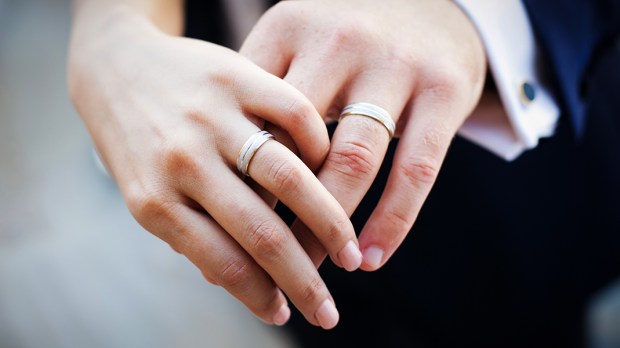Though wedding rings have been a part of marriage ritual since antiquity, the Christian symbolism given the simple band of silver or gold gave them a much higher meaning.
Certainly, the Jews and the Romans—and, it is thought, other nations of pagan beliefs—had the tradition of the groom placing a ring on his future wife’s pinkie finger, but that ring had a different meaning. It was a vote of confidence, giving her a replica of the personal ring or seal that the husband wore on his thumb, with which he sealed his confidential letters and his contracts. It was a tradition more proper to powerful upper classes than to common folk.
However, it’s different when both a man and a woman, of any social class, exchange wedding rings on their wedding day, placing the ring on the ring finger of the left hand, next to the middle finger. The middle finger [which is called the “heart finger” in Spanish – translator’s note] is the one in which we feel most strongly the beating of our heart; this symbolizes the love which must be reserved for God.
It might sound very romantic and even sentimental, but this tradition, which was born in this form in Europe in the 6th century, spread across the entire planet, and even today, brides and grooms of so many religions and cultures exchange rings when they marry, placing them on what is now universally called the ring finger of the left hand.
In some countries, the rings are called “alianzas” (“covenants”), and it is common for them to be carried into the church solemnly on a small cushion borne in the hands of a child. During the sacramental rite, the priest blesses the rings and sprinkles them with holy water. Immediately afterward, he invites the bride and groom to place the rings on each other’s fingers, repeating vows of commitment, fidelity, and love.
Of course, this small ceremony, included within the sacramental liturgy, is not obligatory, nor would its absence invalidate the marriage. However, this rite—dignified by the supernatural solemnity of the liturgy, as only the Church could have conceived, for the greater glory of God and the strengthening of conjugal love—expresses more fully the meaning of the couple’s mutual covenant.
In fact, the wedding ring can become an authentic sacramental, like the “Piscatory Ring” or “Ring of the Fisherman,” which a new pontiff puts on once his election has been proclaimed after a conclave; or like the rings received by certain clergy and consecrated men and women, ranging from cardinals and bishops to some nuns.
Read more:
3 Things you might not know about sacramentals
Blessed and elevated to a new state, a wedding ring goes from being a simple little ring, perhaps made of humble metal, to being an instrument of covenanted life.
It is a sign of the Church’s prayer for its children, it prepares them to receive blessings, and it can also have other effects on spiritual life. It can even have power against temptations and attacks by evil spirits inciting to adultery and fornication.
Always wearing that ring isn’t just an act of love and fidelity, or a spousal duty: even more, it is an effective form of protection.
Some traditions hold that once a couple is married, God assigns a special angel to protect both the marriage as such, and each of the spouses individually in what relates to the marriage, as “one flesh,” which is what they now are. One flesh is what man and woman were when God created Eve from Adam’s rib; they return to being one flesh now, through marriage, until death do them part and they become like angels in heaven. (Mark 12:25)
By Antonio Borda, article originally published by Gaudium Press. Translated and adapted from Aleteia’s Spanish edition.
Read more:
Pope Francis Offers Vigorous Defense of Sacramental Marriage

